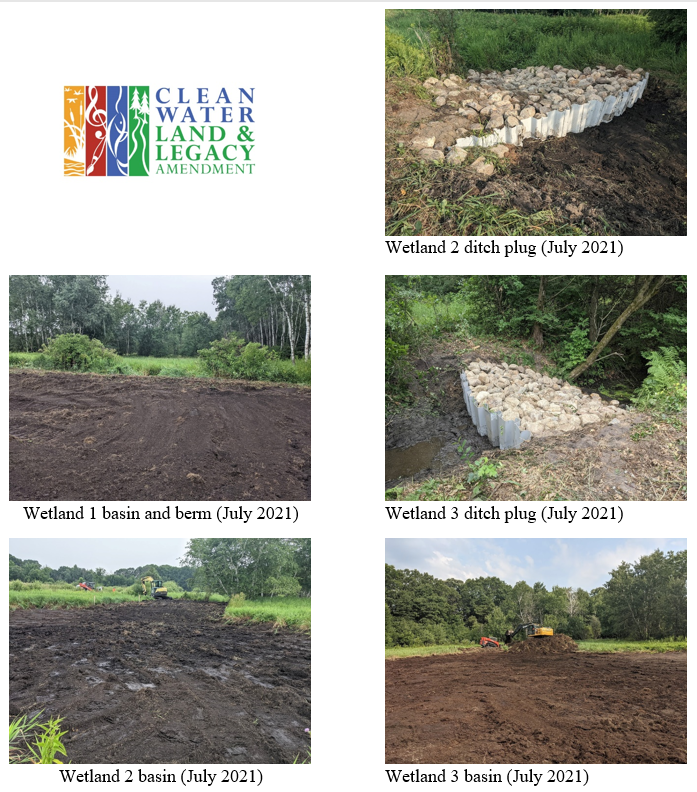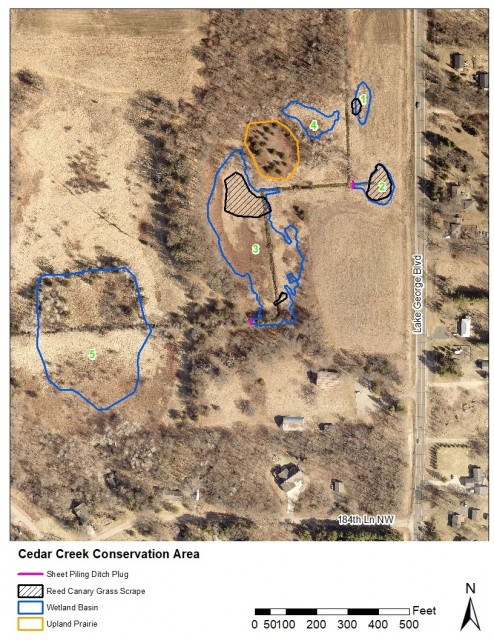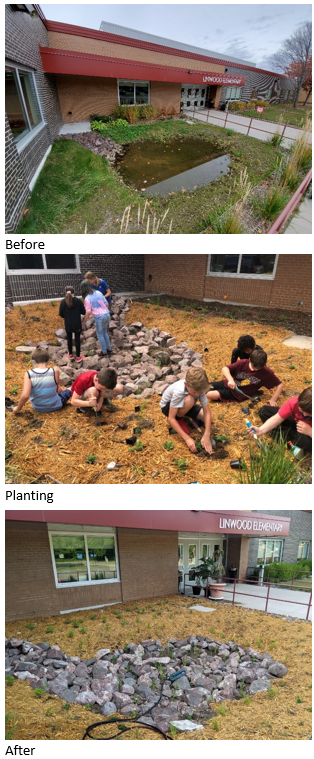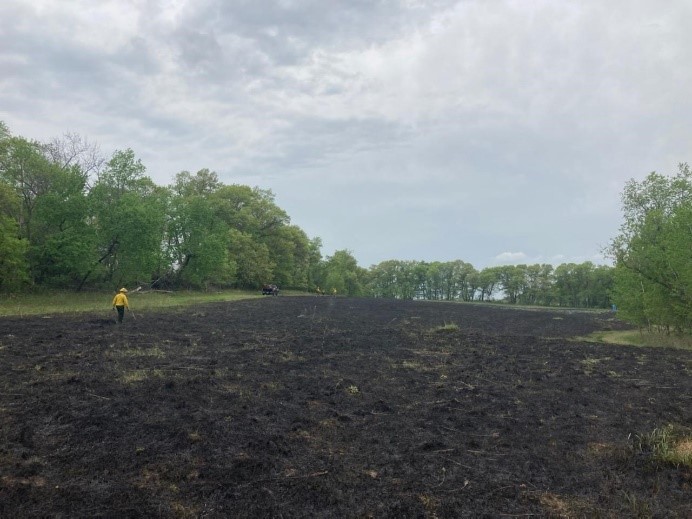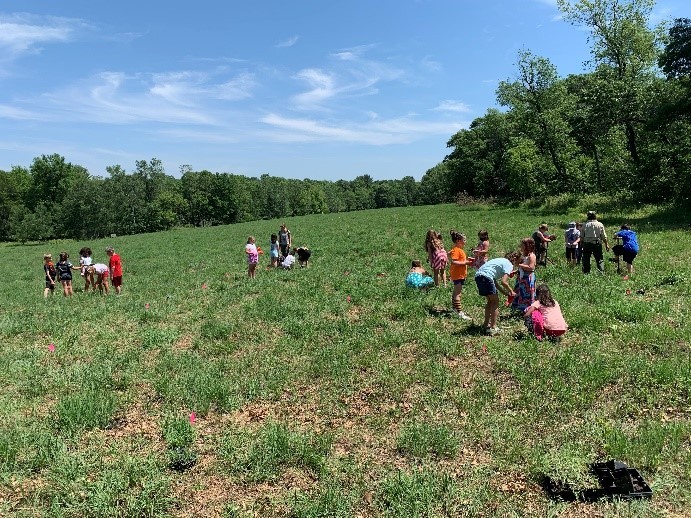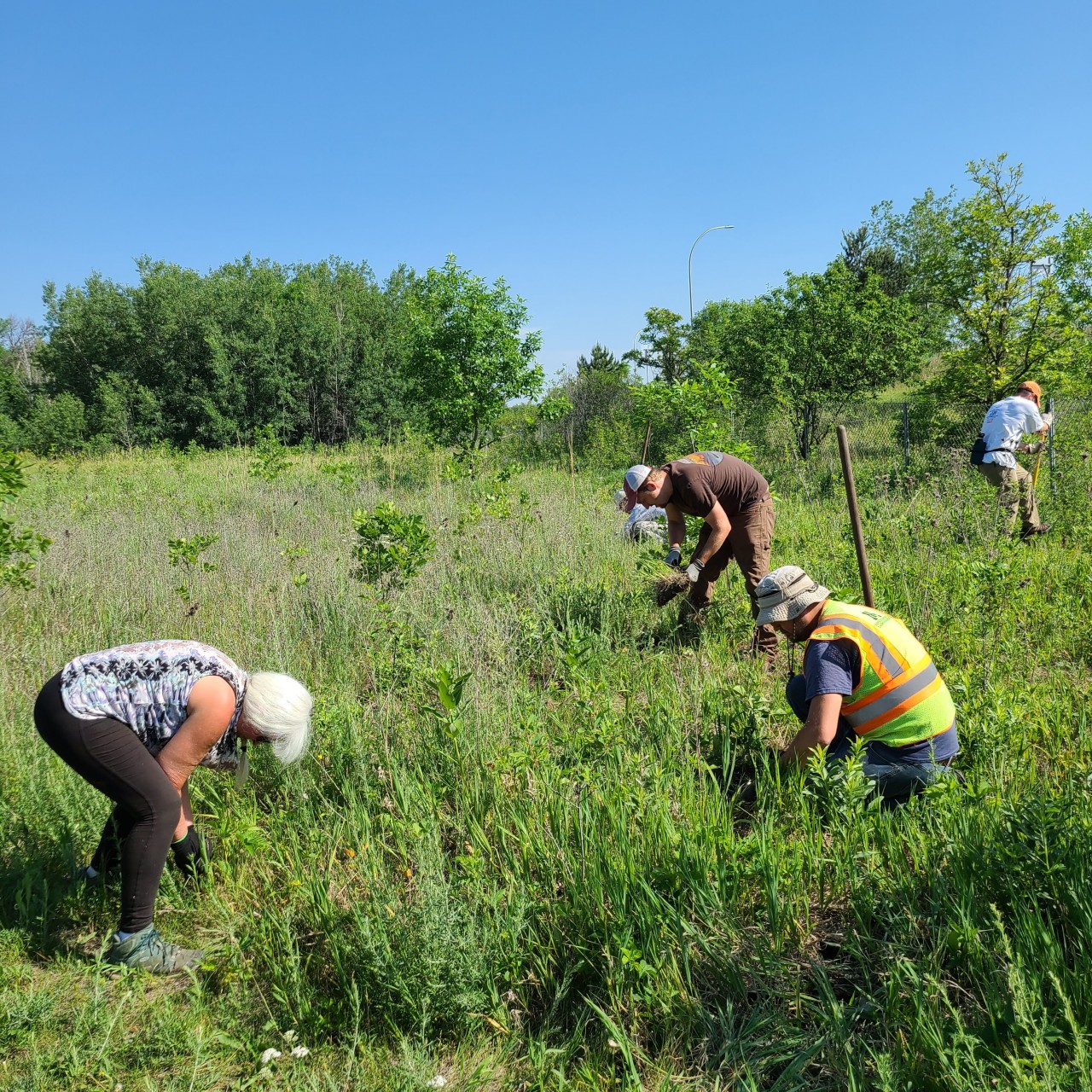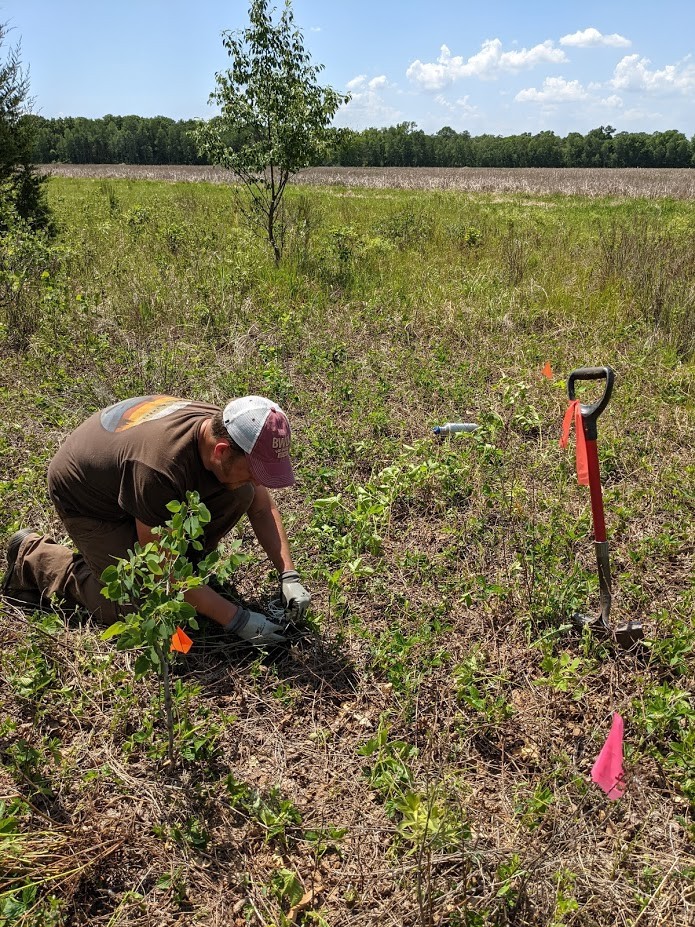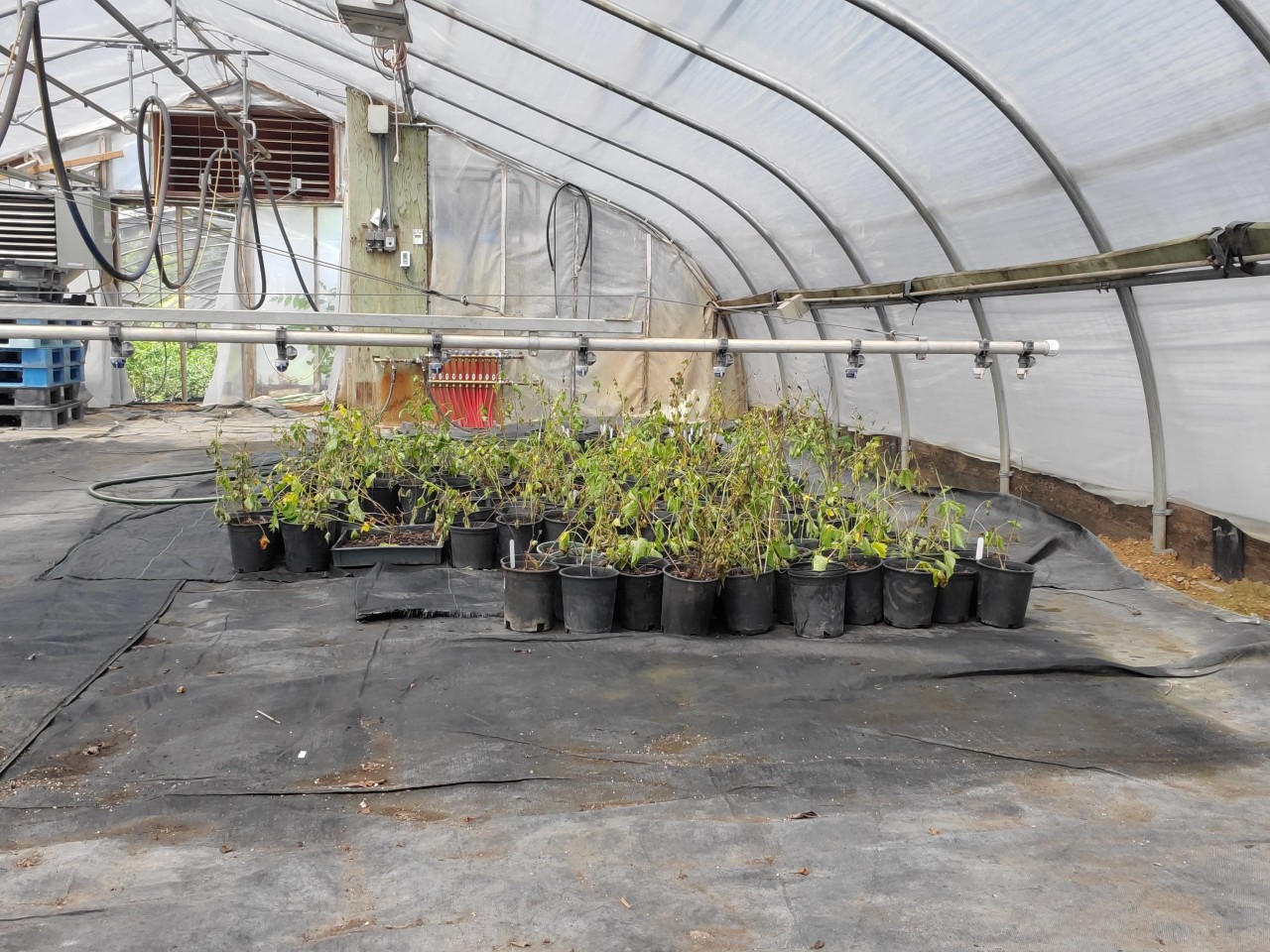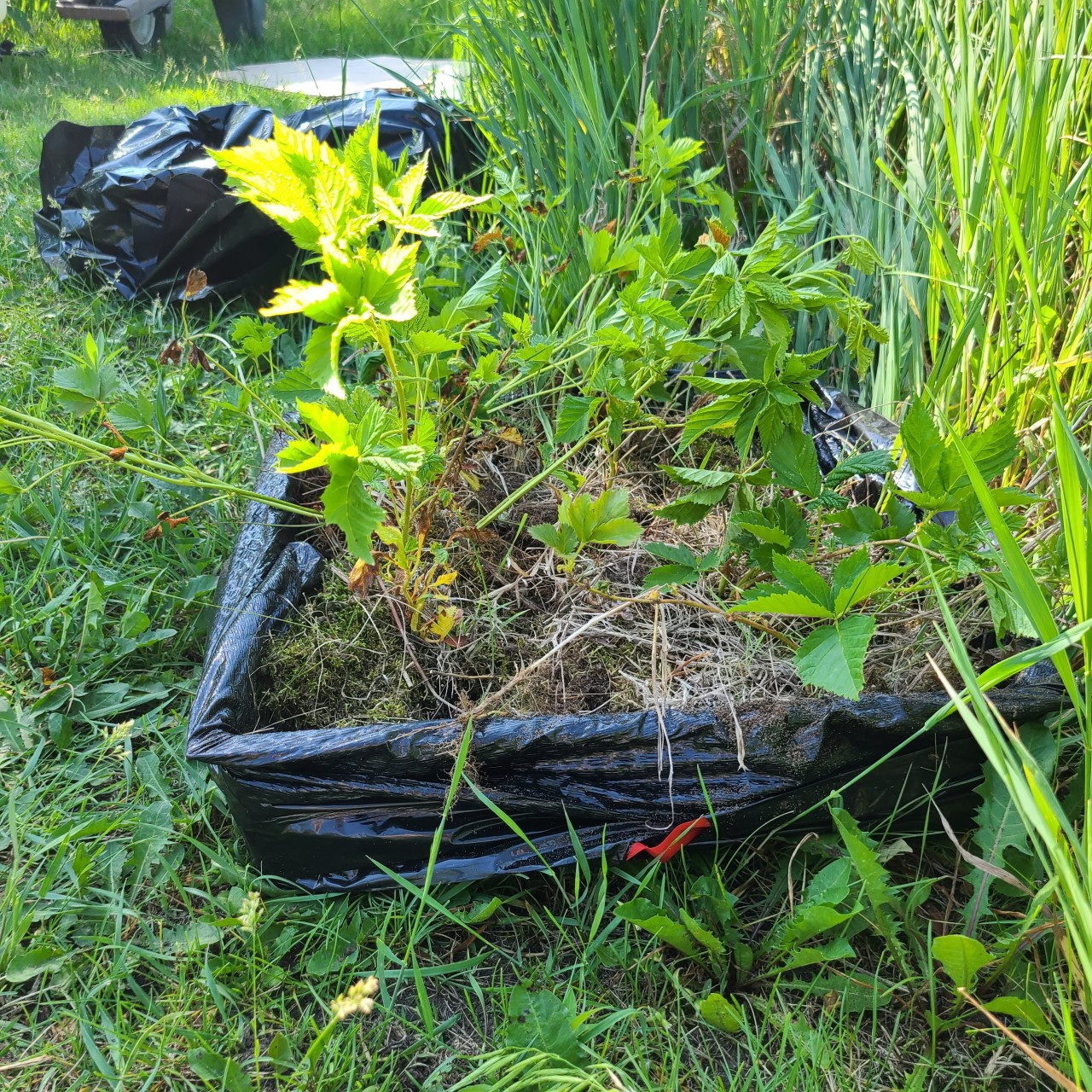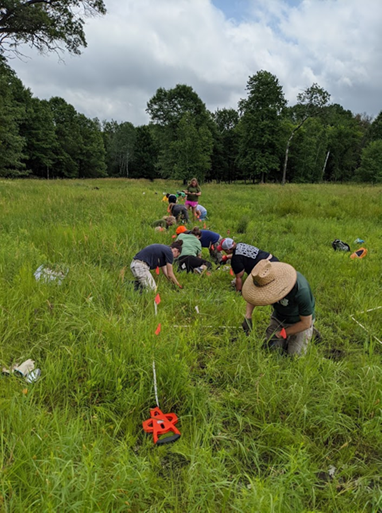The Anoka Conservation District, US Fish and Wildlife Service, and Anoka County Parks are collaborating to restore hydrology and enhance five acres of wetland and one acre of upland prairie at Anoka County Park's Cedar Creek Conservation Area. Two wetland basins were enhanced by installing sheet piling ditch plugs and adding fill material in a private ditch that was draining the wetlands. A berm to prevent water from entering the ditch was constructed to enhance a third wetland basin. Non-native reed canary grass biomass and root sod was scraped from these wetland basins and used to fill the ditch. Construction is complete and vegetation management will occur on these three basins and two additional basins in the area for the next five years using funds from the Lessard-Sams Outdoor Heritage Council. The goal is to convert these once drained wetlands that were dominated by reed canary grass to wetlands with native vegetation and greater water holding capacity. This will provide benefits to water quality and improve wildlife habitat.
Turning a problem into a solution with the Linwood Elementary School rain and pollinator garden.
Construction and expansion took place recently at Linwood Elementary School resulting in a larger roof capturing and sending more rain water to an area in front of the school. This small area is surrounded by the building on two sides, the front sidewalk, and the sidewalk to the main entrance. The additional water produced a large deep puddle for several days and a mud pit after water finally infiltrated. There was a need to improve that area for safety and aesthetics especially since it is in front of the school entrance. The solution: a rain and pollinator garden.
The depressed basin provides a micro example of different hydrologic zones and plant communities ranging from upland plants on the perimeter of the area and wetland plants down in the basin. Parent volunteer, Jennifer Braido took the lead to help facilitate and three 4th grade classes learned about rain gardens so they could create a design for the rain and pollinator garden. ACD staff and Jennifer taught 4th graders about hydrologic zones, plant communities, wetland indicator status, plant adaptations including aerenchyma tissue in wetland plant roots and plant's seasonal bloom times. With all this information, the classes choose their favorite plants for different zones of the garden and did some math to determine how many plants they needed. Another parent volunteer, Robb Johnson, and ACD staff worked to increase water storage capacity by installing a French drain which has reduced the time of standing water after a large rainfall. Finally, the 4th graders were out planting their rain-pollinator garden with the upland species along the edges and the wetland species down in the basin. While they were planting, a monarch butterfly fluttered around appreciating this new habitat. An educational sign is posted to highlight the benefits of rain and pollinator gardens to all that pass by the main entrance to Linwood Elementary School.
There has been a flurry of activity in the Gordie Mikkelson WMA prairies this spring. ACD is working with the MN DNR, Native Resource Preservation, and Linwood Elementary School to enhance 9.3 acres of prairie and add more species of native grasses and wildflowers in the already established windswept prairie. The 840-acre Gordie Mikkelson WMA is ranked as high biodiversity by the MN Biological Survey, and is an example of the mosaic Anoka Sand Plain landscape, containing a diversity of native plant communities including oak woodlands, sedge meadows, wetlands, and swamps. The MN DNR restored three grassland areas in Gordie Mikkelson WMA to native dry prairie. A remaining 9.3 acres are now undergoing restoration/enhancement. The goal is to convert these areas mostly dominated by non- native smooth brome and quackgrass to a dry prairie plant community (UPs13/Southern Upland Prairie System). Native Resource Preservation (NRP) conducted site preparation herbicide treatments in fall 2019 and fall 2020. The MN DNR conducted a prescribed burn in spring 2021 and NRP spread a diverse seed mix following the Rx burn and will follow up with establishment mowing. The already established windswept prairie is near the Linwood Elementary School and along the trail to their School Forest. This location provides a great opportunity to create a diverse prairie for future seed collection. ACD staff and 16 Linwood Elementary School classes planted 28 different species of plant plugs to add diversity and start a seed source that can be collected and spread to other prairies in the Mikkelson WMA.
ACD, Critical Connections Ecological Services, MN Landscape Arboretum, and 17 volunteers salvaged 500 State Endangered rubus stipulatus plants from a proposed development site. This was made possible by working closely with the MN DNR Endangered Species Consultant to incorporate the group's permitted salvage plan with the developer's permit to Take Threatened/ Endangered (T/E) Species for development. If T/E species are found on a site, developers are required to apply for a Permit for the Take of Endangered or Threatened Species Incidental to a Development Project which includes compensatory mitigation. For the first time, the DNR also included our group's salvage plan in part of the Take permit. There was a short window of time between the paperwork and the construction to salvage and transplant. Thankfully volunteers showed up to help out despite the 90-degree temperatures. Plants were transplanted into experimental plots at Bunker Regional Park, City of Blaine Pioneer Park, and Lino Lakes Woolan Park. Plants were also taken to the MN Landscape Arboretum where volunteers potted them for safe keeping for future planting. These 200 potted plants will likely be planted into experimental plots in the fall at Bunker Regional Park, City of Blaine Pioneer Park, Lino Lakes Woolan Park, Blaine Wetland Sanctuary and Columbus Lake Conservation Area. This is the first Endangered Species the Rare Plant Rescue Program has salvaged.
Staff from Anoka Conservation District, Critical Connections Ecological Services, and Minnesota Landscape Arboretum will work with volunteers the last week of April to salvage up to 1,000 State Endangered Rubus stipulatus from a development site and transplant them into protected sites.
Rare plant rescue has been made possible with MN DNR's permit application for the Propagation of Endangered or Threatened Species, which was developed in 2019. Since the release of the permit application, approximately 7,500 State Threatened lance-leaved violets (viola lanceolata) and 150 State Threated swamp blackberry (rubus semisetosus) have been salvaged from three development sites and transplanted into protected sites where their populations are monitored.
To learn more about rare species in Minnesota, go the MN DNR's Rare Species Guide:https://www.dnr.state.mn.us/rsg/index.html
